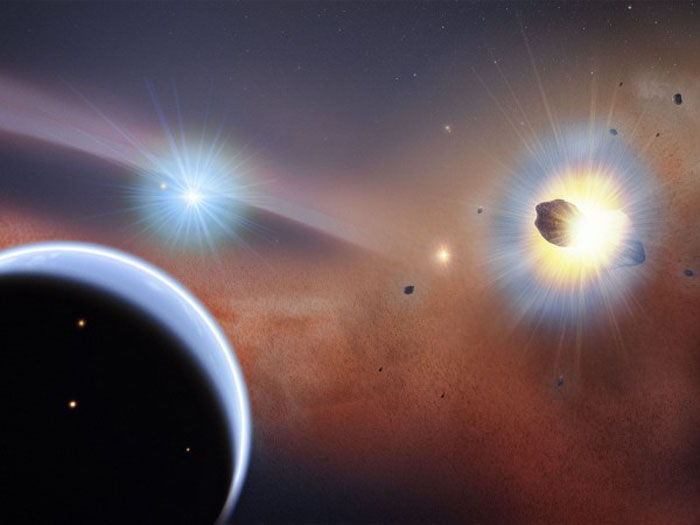.

Comets whizzing beyond our solar system made a big splash last year when astronomers discovered that they could be as common as alien planets. Now, for the first time, researchers have surveyed a large population of these “exocomets” around the young star Beta Pictoris. In the process, they uncovered a tale of two comet families that might help explain how planetary systems like our own formed.
“It’s a real breakthrough due to [the researchers’] dedicated monitoring of the [Beta Pictoris] system,” says astronomer Aki Roberge of the NASA Goddard Space Flight Center in Greenbelt, Maryland, who was not involved in the study.
Disks of debris spinning around young stars clump to form planets, and comets are the small, fragile leftovers from the process. Some think such icy dirtballs in our own solar system might have brought water and the carbon-based building blocks of life to early Earth. Astronomers have observed a few thousand comets in our solar system and have found 10 other comet-hosting stars. The first such star they identified is Beta Pictoris, a 23-million-year-old star in the early stage of building its planets, about 63 light-years away from our 4.6-billion-year-old solar system.
Scientists want to study the behaviors of exocomets, which represent the link between fully formed planets and the debris disks, but individual comets around alien suns are too dark and small to be observed directly. So astronomer Flavien Kiefer of the Paris Institute of Astrophysics and colleagues looked for chemical signatures of the comets’ tails in the Beta Pictoris system. They analyzed images called spectra taken by the High Accuracy Radial velocity Planet Searcher (HARPS) spectrograph, an instrument designed to search for exoplanets. The spectra display light coming from the star Beta Pictoris as a band of rainbow colors showing the amount of light in each wavelength.
When comets approach their host stars, their surfaces warm up, and volatile materials such as ice start to vaporize, forming long tails of gas and debris that absorb specific colors of light from their host stars. So when an exocomet passes in front of the star Beta Pictoris, it changes the spectrum of the star observed by the HARPS instrument.
After analyzing more than 1000 high-resolution spectra of Beta Pictoris collected from 2003 to 2011, the researchers found light-absorption patterns suggesting nearly 500 detections of comets around the star. In particular, the patterns point to two distinct families of comets passing in front of the star, they report online today in Nature.
One family of exocomets appears to have very similar orbits, all coming in toward the star like a string of pearls. Those exocomets also produce a lot more gas than typical comets do, a peculiarity that the researchers say could indicate that they have fresh icy surfaces prolifically evaporating. That’s most likely because they are fragments of a larger icy body, say a planet, that recently broke up, the researchers suggest. A similar example would be the Kreutz family of comets in our solar system, believed to have originated from the gradual breakup of a great comet.
In contrast, exocomets in the other family stray in different orbits and directions. They also appear to evaporate more slowly. That could indicate that they are older comets trapped by the gravity of planets in such a way that their icy surfaces have been depleted through evaporation, the researchers say.
The discovery still doesn’t provide direct evidence of the exocomets’ existence, but it could pave the way for a better understanding of comets in distant planetary systems and our own solar system. If the “string-of-pearls” exocomets are indeed fragments of a larger body, they could help astronomers understand the composition of their massive parent, Roberge says. Typically, researchers could observe only the surface of such alien bodies but not the interior; NASA’s 2005 Deep Impact mission actually smashed a comet to study its composition. The exocomet family on Beta Pictoris, on the other hand, may provide similar evidence for free, she says.
The orbits of exocomets on Beta Pictoris could also help scientists trace the presence and migration of larger, undetected bodies such as gas giant planets in the planetary system, says Russel White, an astronomer at Georgia State University in Atlanta who was not involved in the study. In our solar system, the giant planets Jupiter and Saturn were thought to have moved toward and then away from the sun during the early years of the solar system—events believed to have destabilized the entire planetary system. Such large bodies would affect the orbits of exocomets in the Beta Pictoris system, giving astronomers clues to their presence and movement.
“We are now witnessing what is happening in a young planetary system … phenomena that were expected to have taken place in the solar system itself,” Kiefer says.
Quelle: AAAS
4812 Views
